Exploring the Difficulties and Rights of Refugees in Australia
VerifiedAdded on 2021/02/20
|7
|2085
|28
Essay
AI Summary
This essay provides a comprehensive overview of the challenges faced by refugees in Australia, examining their vulnerabilities, difficulties, and the support systems available to them. It delves into the definition of a refugee under international law, the issues of persecution, discrimination, and cultural adaptation, and the pre-arrival experiences that shape their integration. The essay explores the difficulties in accessing basic needs, including visa issues and healthcare, and outlines the Australian government's humanitarian programs, including offshore and onshore protection visas. It also discusses intervention measures, such as educational programs and mental health support, aimed at helping refugees adapt to their new environment. The essay draws on various articles and journals to analyze the viewpoints of authors and understand the complex issues faced by refugees, highlighting the importance of providing comprehensive support to help them rebuild their lives.

Essay
Paraphrase This Document
Need a fresh take? Get an instant paraphrase of this document with our AI Paraphraser

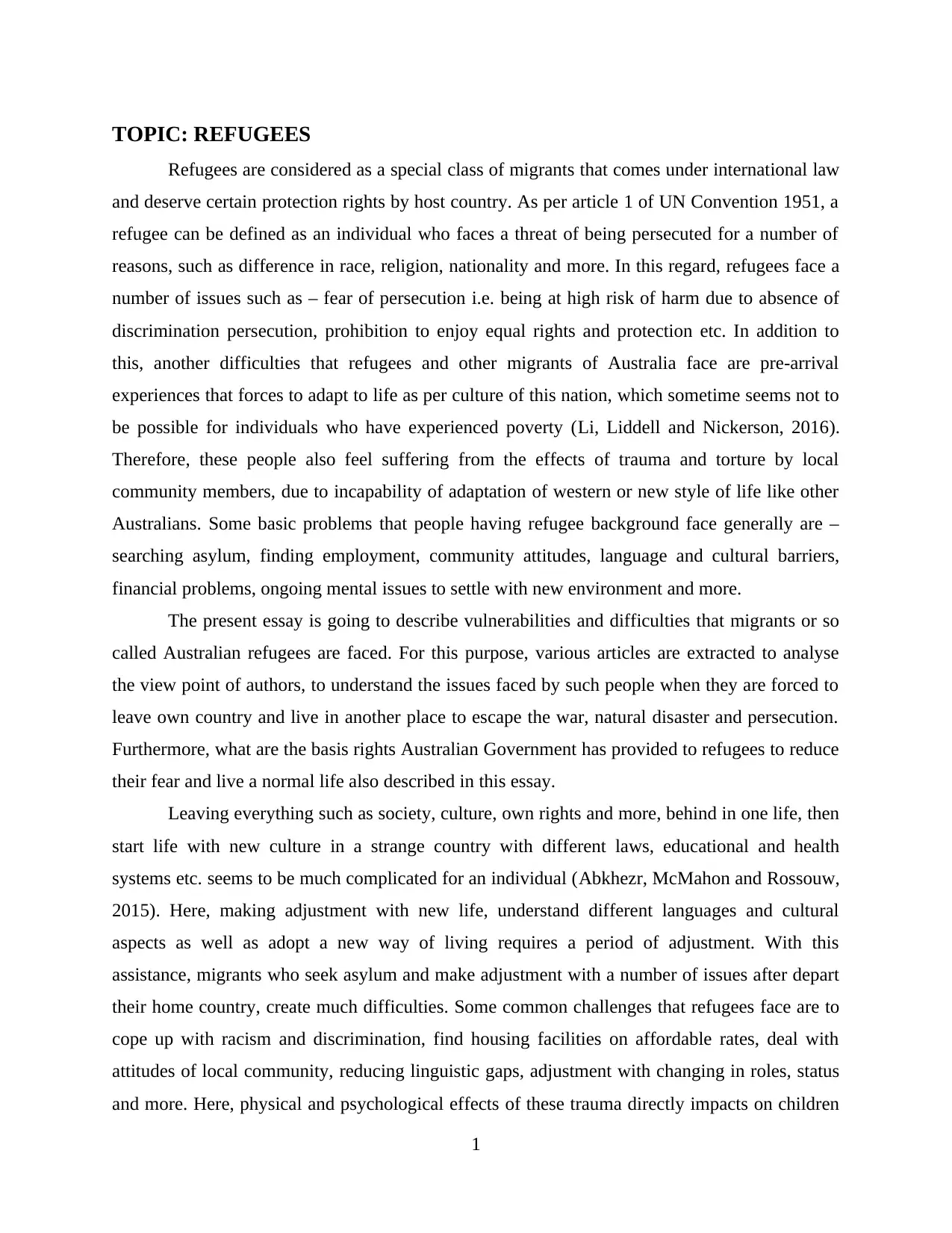
TOPIC: REFUGEES
Refugees are considered as a special class of migrants that comes under international law
and deserve certain protection rights by host country. As per article 1 of UN Convention 1951, a
refugee can be defined as an individual who faces a threat of being persecuted for a number of
reasons, such as difference in race, religion, nationality and more. In this regard, refugees face a
number of issues such as – fear of persecution i.e. being at high risk of harm due to absence of
discrimination persecution, prohibition to enjoy equal rights and protection etc. In addition to
this, another difficulties that refugees and other migrants of Australia face are pre-arrival
experiences that forces to adapt to life as per culture of this nation, which sometime seems not to
be possible for individuals who have experienced poverty (Li, Liddell and Nickerson, 2016).
Therefore, these people also feel suffering from the effects of trauma and torture by local
community members, due to incapability of adaptation of western or new style of life like other
Australians. Some basic problems that people having refugee background face generally are –
searching asylum, finding employment, community attitudes, language and cultural barriers,
financial problems, ongoing mental issues to settle with new environment and more.
The present essay is going to describe vulnerabilities and difficulties that migrants or so
called Australian refugees are faced. For this purpose, various articles are extracted to analyse
the view point of authors, to understand the issues faced by such people when they are forced to
leave own country and live in another place to escape the war, natural disaster and persecution.
Furthermore, what are the basis rights Australian Government has provided to refugees to reduce
their fear and live a normal life also described in this essay.
Leaving everything such as society, culture, own rights and more, behind in one life, then
start life with new culture in a strange country with different laws, educational and health
systems etc. seems to be much complicated for an individual (Abkhezr, McMahon and Rossouw,
2015). Here, making adjustment with new life, understand different languages and cultural
aspects as well as adopt a new way of living requires a period of adjustment. With this
assistance, migrants who seek asylum and make adjustment with a number of issues after depart
their home country, create much difficulties. Some common challenges that refugees face are to
cope up with racism and discrimination, find housing facilities on affordable rates, deal with
attitudes of local community, reducing linguistic gaps, adjustment with changing in roles, status
and more. Here, physical and psychological effects of these trauma directly impacts on children
1
Refugees are considered as a special class of migrants that comes under international law
and deserve certain protection rights by host country. As per article 1 of UN Convention 1951, a
refugee can be defined as an individual who faces a threat of being persecuted for a number of
reasons, such as difference in race, religion, nationality and more. In this regard, refugees face a
number of issues such as – fear of persecution i.e. being at high risk of harm due to absence of
discrimination persecution, prohibition to enjoy equal rights and protection etc. In addition to
this, another difficulties that refugees and other migrants of Australia face are pre-arrival
experiences that forces to adapt to life as per culture of this nation, which sometime seems not to
be possible for individuals who have experienced poverty (Li, Liddell and Nickerson, 2016).
Therefore, these people also feel suffering from the effects of trauma and torture by local
community members, due to incapability of adaptation of western or new style of life like other
Australians. Some basic problems that people having refugee background face generally are –
searching asylum, finding employment, community attitudes, language and cultural barriers,
financial problems, ongoing mental issues to settle with new environment and more.
The present essay is going to describe vulnerabilities and difficulties that migrants or so
called Australian refugees are faced. For this purpose, various articles are extracted to analyse
the view point of authors, to understand the issues faced by such people when they are forced to
leave own country and live in another place to escape the war, natural disaster and persecution.
Furthermore, what are the basis rights Australian Government has provided to refugees to reduce
their fear and live a normal life also described in this essay.
Leaving everything such as society, culture, own rights and more, behind in one life, then
start life with new culture in a strange country with different laws, educational and health
systems etc. seems to be much complicated for an individual (Abkhezr, McMahon and Rossouw,
2015). Here, making adjustment with new life, understand different languages and cultural
aspects as well as adopt a new way of living requires a period of adjustment. With this
assistance, migrants who seek asylum and make adjustment with a number of issues after depart
their home country, create much difficulties. Some common challenges that refugees face are to
cope up with racism and discrimination, find housing facilities on affordable rates, deal with
attitudes of local community, reducing linguistic gaps, adjustment with changing in roles, status
and more. Here, physical and psychological effects of these trauma directly impacts on children
1
⊘ This is a preview!⊘
Do you want full access?
Subscribe today to unlock all pages.

Trusted by 1+ million students worldwide
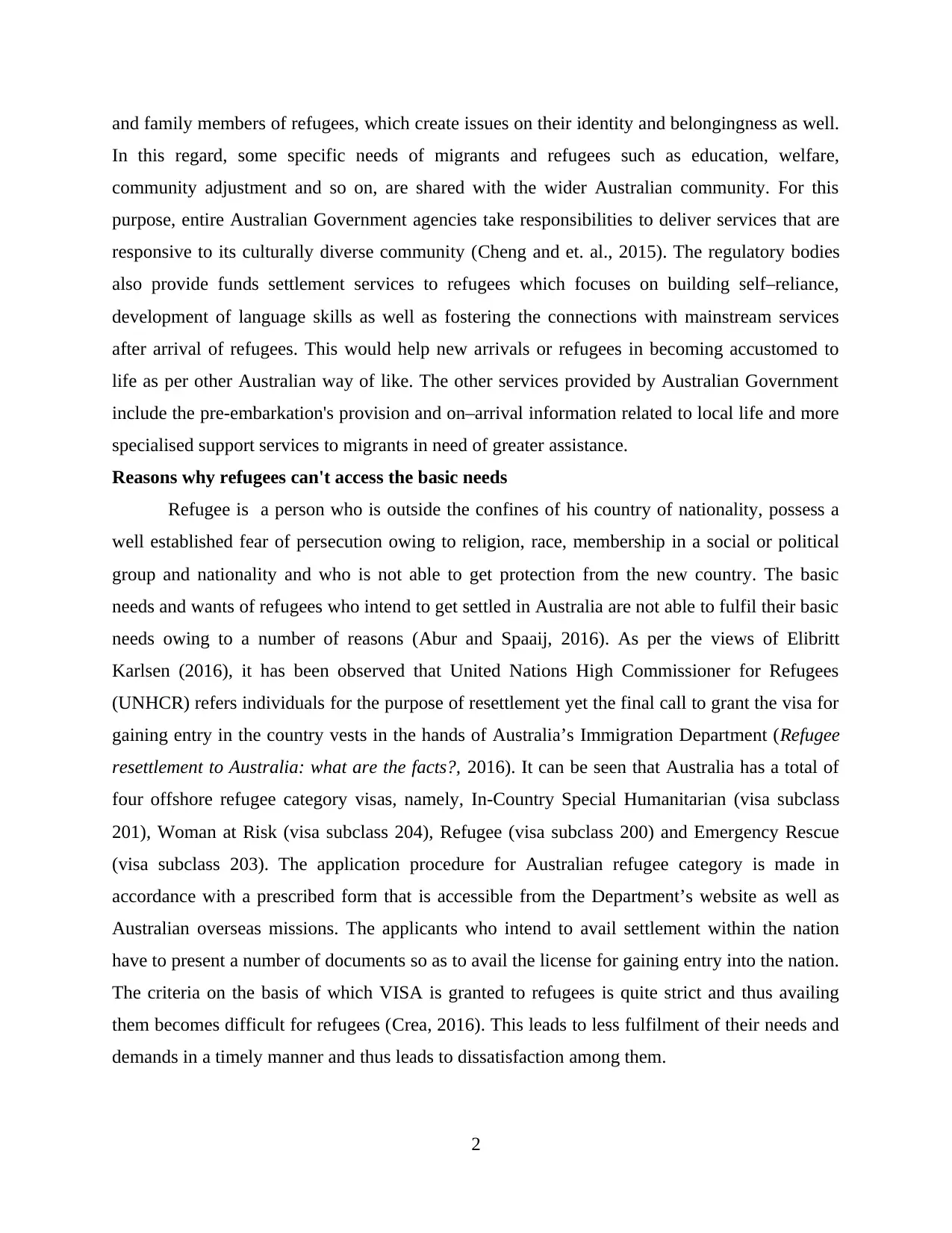
and family members of refugees, which create issues on their identity and belongingness as well.
In this regard, some specific needs of migrants and refugees such as education, welfare,
community adjustment and so on, are shared with the wider Australian community. For this
purpose, entire Australian Government agencies take responsibilities to deliver services that are
responsive to its culturally diverse community (Cheng and et. al., 2015). The regulatory bodies
also provide funds settlement services to refugees which focuses on building self–reliance,
development of language skills as well as fostering the connections with mainstream services
after arrival of refugees. This would help new arrivals or refugees in becoming accustomed to
life as per other Australian way of like. The other services provided by Australian Government
include the pre-embarkation's provision and on–arrival information related to local life and more
specialised support services to migrants in need of greater assistance.
Reasons why refugees can't access the basic needs
Refugee is a person who is outside the confines of his country of nationality, possess a
well established fear of persecution owing to religion, race, membership in a social or political
group and nationality and who is not able to get protection from the new country. The basic
needs and wants of refugees who intend to get settled in Australia are not able to fulfil their basic
needs owing to a number of reasons (Abur and Spaaij, 2016). As per the views of Elibritt
Karlsen (2016), it has been observed that United Nations High Commissioner for Refugees
(UNHCR) refers individuals for the purpose of resettlement yet the final call to grant the visa for
gaining entry in the country vests in the hands of Australia’s Immigration Department (Refugee
resettlement to Australia: what are the facts?, 2016). It can be seen that Australia has a total of
four offshore refugee category visas, namely, In‐Country Special Humanitarian (visa subclass
201), Woman at Risk (visa subclass 204), Refugee (visa subclass 200) and Emergency Rescue
(visa subclass 203). The application procedure for Australian refugee category is made in
accordance with a prescribed form that is accessible from the Department’s website as well as
Australian overseas missions. The applicants who intend to avail settlement within the nation
have to present a number of documents so as to avail the license for gaining entry into the nation.
The criteria on the basis of which VISA is granted to refugees is quite strict and thus availing
them becomes difficult for refugees (Crea, 2016). This leads to less fulfilment of their needs and
demands in a timely manner and thus leads to dissatisfaction among them.
2
In this regard, some specific needs of migrants and refugees such as education, welfare,
community adjustment and so on, are shared with the wider Australian community. For this
purpose, entire Australian Government agencies take responsibilities to deliver services that are
responsive to its culturally diverse community (Cheng and et. al., 2015). The regulatory bodies
also provide funds settlement services to refugees which focuses on building self–reliance,
development of language skills as well as fostering the connections with mainstream services
after arrival of refugees. This would help new arrivals or refugees in becoming accustomed to
life as per other Australian way of like. The other services provided by Australian Government
include the pre-embarkation's provision and on–arrival information related to local life and more
specialised support services to migrants in need of greater assistance.
Reasons why refugees can't access the basic needs
Refugee is a person who is outside the confines of his country of nationality, possess a
well established fear of persecution owing to religion, race, membership in a social or political
group and nationality and who is not able to get protection from the new country. The basic
needs and wants of refugees who intend to get settled in Australia are not able to fulfil their basic
needs owing to a number of reasons (Abur and Spaaij, 2016). As per the views of Elibritt
Karlsen (2016), it has been observed that United Nations High Commissioner for Refugees
(UNHCR) refers individuals for the purpose of resettlement yet the final call to grant the visa for
gaining entry in the country vests in the hands of Australia’s Immigration Department (Refugee
resettlement to Australia: what are the facts?, 2016). It can be seen that Australia has a total of
four offshore refugee category visas, namely, In‐Country Special Humanitarian (visa subclass
201), Woman at Risk (visa subclass 204), Refugee (visa subclass 200) and Emergency Rescue
(visa subclass 203). The application procedure for Australian refugee category is made in
accordance with a prescribed form that is accessible from the Department’s website as well as
Australian overseas missions. The applicants who intend to avail settlement within the nation
have to present a number of documents so as to avail the license for gaining entry into the nation.
The criteria on the basis of which VISA is granted to refugees is quite strict and thus availing
them becomes difficult for refugees (Crea, 2016). This leads to less fulfilment of their needs and
demands in a timely manner and thus leads to dissatisfaction among them.
2
Paraphrase This Document
Need a fresh take? Get an instant paraphrase of this document with our AI Paraphraser
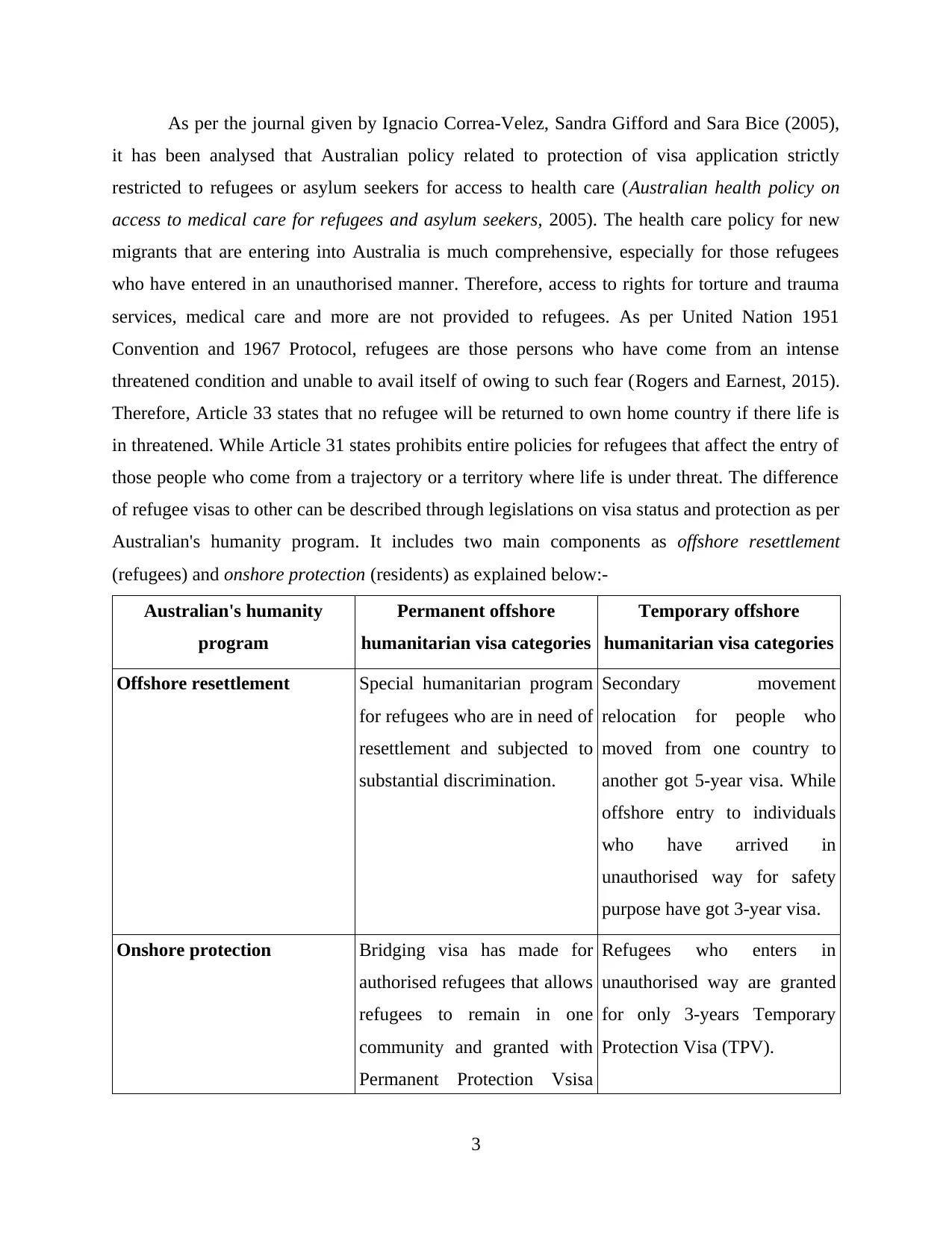
As per the journal given by Ignacio Correa-Velez, Sandra Gifford and Sara Bice (2005),
it has been analysed that Australian policy related to protection of visa application strictly
restricted to refugees or asylum seekers for access to health care (Australian health policy on
access to medical care for refugees and asylum seekers, 2005). The health care policy for new
migrants that are entering into Australia is much comprehensive, especially for those refugees
who have entered in an unauthorised manner. Therefore, access to rights for torture and trauma
services, medical care and more are not provided to refugees. As per United Nation 1951
Convention and 1967 Protocol, refugees are those persons who have come from an intense
threatened condition and unable to avail itself of owing to such fear (Rogers and Earnest, 2015).
Therefore, Article 33 states that no refugee will be returned to own home country if there life is
in threatened. While Article 31 states prohibits entire policies for refugees that affect the entry of
those people who come from a trajectory or a territory where life is under threat. The difference
of refugee visas to other can be described through legislations on visa status and protection as per
Australian's humanity program. It includes two main components as offshore resettlement
(refugees) and onshore protection (residents) as explained below:-
Australian's humanity
program
Permanent offshore
humanitarian visa categories
Temporary offshore
humanitarian visa categories
Offshore resettlement Special humanitarian program
for refugees who are in need of
resettlement and subjected to
substantial discrimination.
Secondary movement
relocation for people who
moved from one country to
another got 5-year visa. While
offshore entry to individuals
who have arrived in
unauthorised way for safety
purpose have got 3-year visa.
Onshore protection Bridging visa has made for
authorised refugees that allows
refugees to remain in one
community and granted with
Permanent Protection Vsisa
Refugees who enters in
unauthorised way are granted
for only 3-years Temporary
Protection Visa (TPV).
3
it has been analysed that Australian policy related to protection of visa application strictly
restricted to refugees or asylum seekers for access to health care (Australian health policy on
access to medical care for refugees and asylum seekers, 2005). The health care policy for new
migrants that are entering into Australia is much comprehensive, especially for those refugees
who have entered in an unauthorised manner. Therefore, access to rights for torture and trauma
services, medical care and more are not provided to refugees. As per United Nation 1951
Convention and 1967 Protocol, refugees are those persons who have come from an intense
threatened condition and unable to avail itself of owing to such fear (Rogers and Earnest, 2015).
Therefore, Article 33 states that no refugee will be returned to own home country if there life is
in threatened. While Article 31 states prohibits entire policies for refugees that affect the entry of
those people who come from a trajectory or a territory where life is under threat. The difference
of refugee visas to other can be described through legislations on visa status and protection as per
Australian's humanity program. It includes two main components as offshore resettlement
(refugees) and onshore protection (residents) as explained below:-
Australian's humanity
program
Permanent offshore
humanitarian visa categories
Temporary offshore
humanitarian visa categories
Offshore resettlement Special humanitarian program
for refugees who are in need of
resettlement and subjected to
substantial discrimination.
Secondary movement
relocation for people who
moved from one country to
another got 5-year visa. While
offshore entry to individuals
who have arrived in
unauthorised way for safety
purpose have got 3-year visa.
Onshore protection Bridging visa has made for
authorised refugees that allows
refugees to remain in one
community and granted with
Permanent Protection Vsisa
Refugees who enters in
unauthorised way are granted
for only 3-years Temporary
Protection Visa (TPV).
3
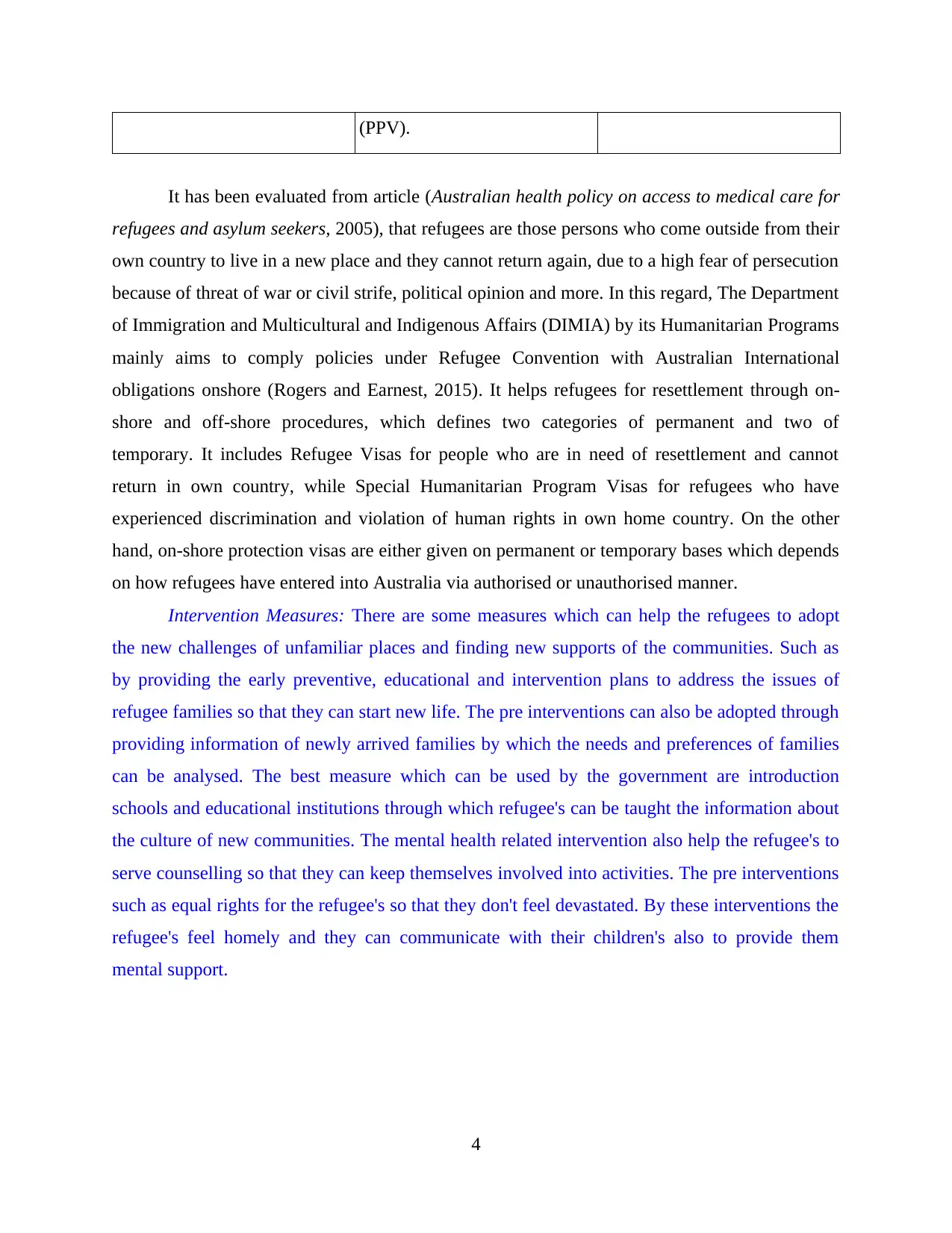
(PPV).
It has been evaluated from article (Australian health policy on access to medical care for
refugees and asylum seekers, 2005), that refugees are those persons who come outside from their
own country to live in a new place and they cannot return again, due to a high fear of persecution
because of threat of war or civil strife, political opinion and more. In this regard, The Department
of Immigration and Multicultural and Indigenous Affairs (DIMIA) by its Humanitarian Programs
mainly aims to comply policies under Refugee Convention with Australian International
obligations onshore (Rogers and Earnest, 2015). It helps refugees for resettlement through on-
shore and off-shore procedures, which defines two categories of permanent and two of
temporary. It includes Refugee Visas for people who are in need of resettlement and cannot
return in own country, while Special Humanitarian Program Visas for refugees who have
experienced discrimination and violation of human rights in own home country. On the other
hand, on-shore protection visas are either given on permanent or temporary bases which depends
on how refugees have entered into Australia via authorised or unauthorised manner.
Intervention Measures: There are some measures which can help the refugees to adopt
the new challenges of unfamiliar places and finding new supports of the communities. Such as
by providing the early preventive, educational and intervention plans to address the issues of
refugee families so that they can start new life. The pre interventions can also be adopted through
providing information of newly arrived families by which the needs and preferences of families
can be analysed. The best measure which can be used by the government are introduction
schools and educational institutions through which refugee's can be taught the information about
the culture of new communities. The mental health related intervention also help the refugee's to
serve counselling so that they can keep themselves involved into activities. The pre interventions
such as equal rights for the refugee's so that they don't feel devastated. By these interventions the
refugee's feel homely and they can communicate with their children's also to provide them
mental support.
4
It has been evaluated from article (Australian health policy on access to medical care for
refugees and asylum seekers, 2005), that refugees are those persons who come outside from their
own country to live in a new place and they cannot return again, due to a high fear of persecution
because of threat of war or civil strife, political opinion and more. In this regard, The Department
of Immigration and Multicultural and Indigenous Affairs (DIMIA) by its Humanitarian Programs
mainly aims to comply policies under Refugee Convention with Australian International
obligations onshore (Rogers and Earnest, 2015). It helps refugees for resettlement through on-
shore and off-shore procedures, which defines two categories of permanent and two of
temporary. It includes Refugee Visas for people who are in need of resettlement and cannot
return in own country, while Special Humanitarian Program Visas for refugees who have
experienced discrimination and violation of human rights in own home country. On the other
hand, on-shore protection visas are either given on permanent or temporary bases which depends
on how refugees have entered into Australia via authorised or unauthorised manner.
Intervention Measures: There are some measures which can help the refugees to adopt
the new challenges of unfamiliar places and finding new supports of the communities. Such as
by providing the early preventive, educational and intervention plans to address the issues of
refugee families so that they can start new life. The pre interventions can also be adopted through
providing information of newly arrived families by which the needs and preferences of families
can be analysed. The best measure which can be used by the government are introduction
schools and educational institutions through which refugee's can be taught the information about
the culture of new communities. The mental health related intervention also help the refugee's to
serve counselling so that they can keep themselves involved into activities. The pre interventions
such as equal rights for the refugee's so that they don't feel devastated. By these interventions the
refugee's feel homely and they can communicate with their children's also to provide them
mental support.
4
⊘ This is a preview!⊘
Do you want full access?
Subscribe today to unlock all pages.

Trusted by 1+ million students worldwide
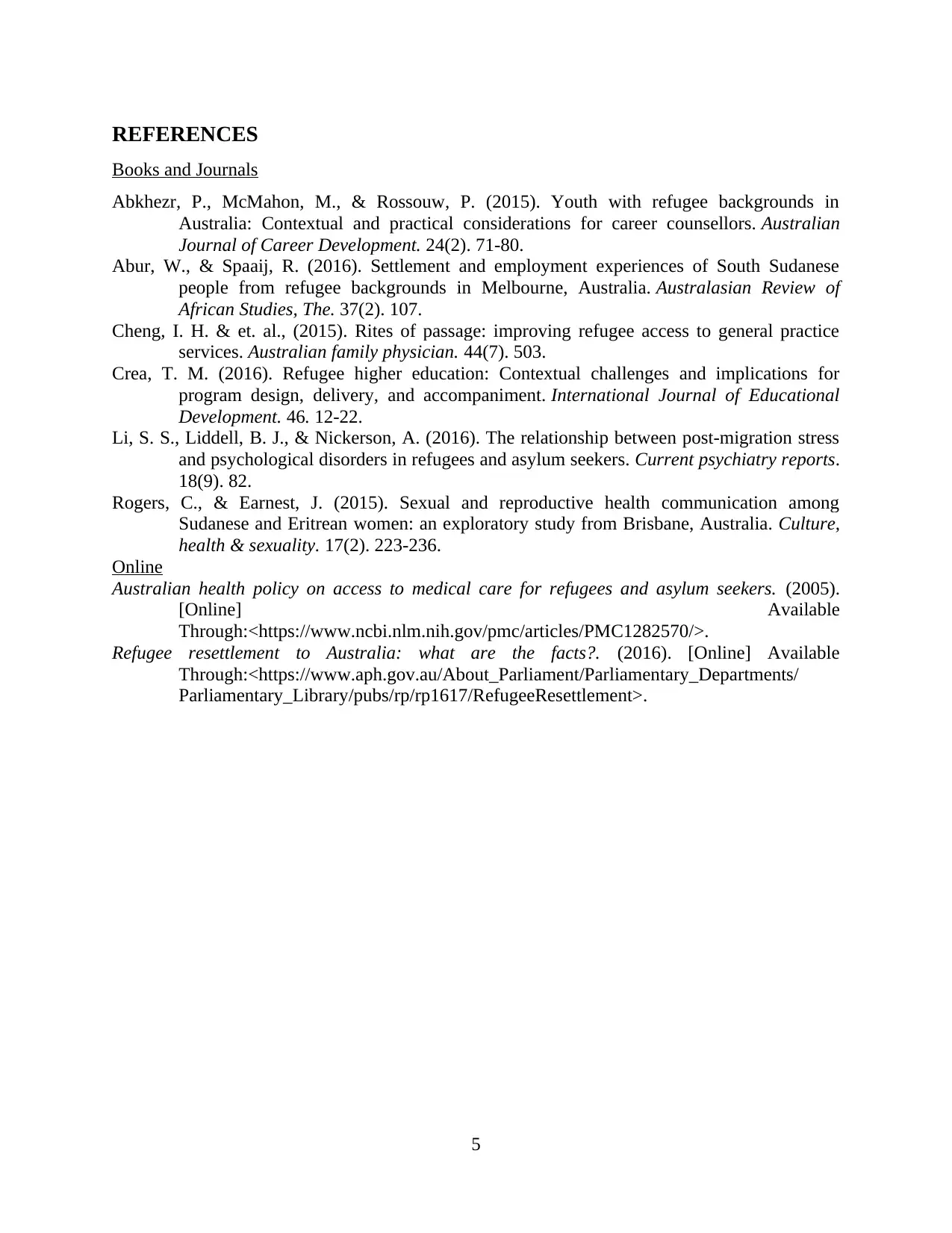
REFERENCES
Books and Journals
Abkhezr, P., McMahon, M., & Rossouw, P. (2015). Youth with refugee backgrounds in
Australia: Contextual and practical considerations for career counsellors. Australian
Journal of Career Development. 24(2). 71-80.
Abur, W., & Spaaij, R. (2016). Settlement and employment experiences of South Sudanese
people from refugee backgrounds in Melbourne, Australia. Australasian Review of
African Studies, The. 37(2). 107.
Cheng, I. H. & et. al., (2015). Rites of passage: improving refugee access to general practice
services. Australian family physician. 44(7). 503.
Crea, T. M. (2016). Refugee higher education: Contextual challenges and implications for
program design, delivery, and accompaniment. International Journal of Educational
Development. 46. 12-22.
Li, S. S., Liddell, B. J., & Nickerson, A. (2016). The relationship between post-migration stress
and psychological disorders in refugees and asylum seekers. Current psychiatry reports.
18(9). 82.
Rogers, C., & Earnest, J. (2015). Sexual and reproductive health communication among
Sudanese and Eritrean women: an exploratory study from Brisbane, Australia. Culture,
health & sexuality. 17(2). 223-236.
Online
Australian health policy on access to medical care for refugees and asylum seekers. (2005).
[Online] Available
Through:<https://www.ncbi.nlm.nih.gov/pmc/articles/PMC1282570/>.
Refugee resettlement to Australia: what are the facts?. (2016). [Online] Available
Through:<https://www.aph.gov.au/About_Parliament/Parliamentary_Departments/
Parliamentary_Library/pubs/rp/rp1617/RefugeeResettlement>.
5
Books and Journals
Abkhezr, P., McMahon, M., & Rossouw, P. (2015). Youth with refugee backgrounds in
Australia: Contextual and practical considerations for career counsellors. Australian
Journal of Career Development. 24(2). 71-80.
Abur, W., & Spaaij, R. (2016). Settlement and employment experiences of South Sudanese
people from refugee backgrounds in Melbourne, Australia. Australasian Review of
African Studies, The. 37(2). 107.
Cheng, I. H. & et. al., (2015). Rites of passage: improving refugee access to general practice
services. Australian family physician. 44(7). 503.
Crea, T. M. (2016). Refugee higher education: Contextual challenges and implications for
program design, delivery, and accompaniment. International Journal of Educational
Development. 46. 12-22.
Li, S. S., Liddell, B. J., & Nickerson, A. (2016). The relationship between post-migration stress
and psychological disorders in refugees and asylum seekers. Current psychiatry reports.
18(9). 82.
Rogers, C., & Earnest, J. (2015). Sexual and reproductive health communication among
Sudanese and Eritrean women: an exploratory study from Brisbane, Australia. Culture,
health & sexuality. 17(2). 223-236.
Online
Australian health policy on access to medical care for refugees and asylum seekers. (2005).
[Online] Available
Through:<https://www.ncbi.nlm.nih.gov/pmc/articles/PMC1282570/>.
Refugee resettlement to Australia: what are the facts?. (2016). [Online] Available
Through:<https://www.aph.gov.au/About_Parliament/Parliamentary_Departments/
Parliamentary_Library/pubs/rp/rp1617/RefugeeResettlement>.
5
1 out of 7
Related Documents
Your All-in-One AI-Powered Toolkit for Academic Success.
+13062052269
info@desklib.com
Available 24*7 on WhatsApp / Email
![[object Object]](/_next/static/media/star-bottom.7253800d.svg)
Unlock your academic potential
Copyright © 2020–2025 A2Z Services. All Rights Reserved. Developed and managed by ZUCOL.





